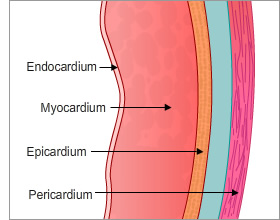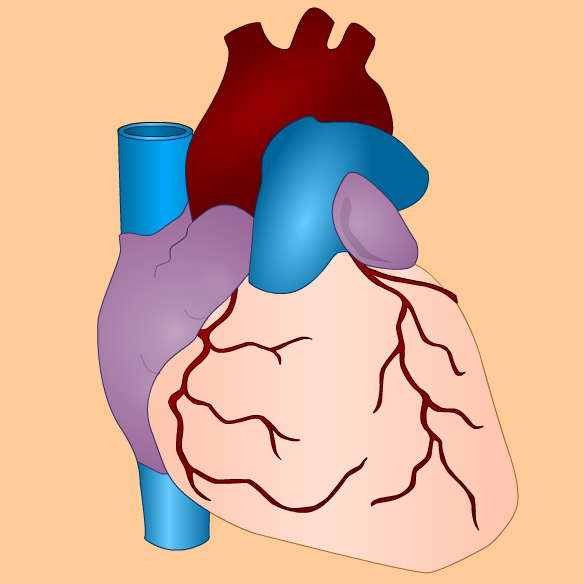The heart is the pump at the centre of the body’s circulatory system. The function of the circulatory system is to supply every cell in the body with essential oxygen, nutrients and hormones, and to remove carbon dioxide (CO2) and other waste products of metabolism .
- The cardiovascular (circulatory) system comprises of 2 loops: the pulmonary and the systemic circulation.
- It may be helpful to think of the heart not as a single pump but rather a left and a right pump.
- LEFT: circulates oxygenated blood through the body (systemic)
- RIGHT: circulates deoxygenated blood through the lungs (pulmonary)
- The total volume of blood pushed from the ventricles in one minute, is known as cardiac output
Reference: Tortora, G.J. & Derrickson B.H. (2009) Principles of Anatomy and Physiology: Organization, support and movement and control of the human body. Vol, 1. 12th Edition. John Wiley & Sons: Hoboken New Jersey
The coronary circulation is the shortest circulation in the body. The primary function of coronary blood flow is to supply enough oxygen to meet the metabolic demands of the heart. Myocardial oxygen consumption varies depending on demand which is influenced by factors such as exercise, drugs and other stimuli.
 3 layers which are all richly supplied with blood vessels:
3 layers which are all richly supplied with blood vessels:
- Epicardium – this is the outer, visceral layer of the pericardium.
- Myocardium – this is the middle, and thickest layer, composed mostly of cardiac muscle cells (myocytes) responsible for cardiac contraction, but also some specialist nerve fibres.
- Endocardium – this is the inner layer of the heart and is a thin layer of endothelium overlaying a thin layer of connective tissue.
The Pericardium is a double layered sac that surrounds the heart.

The heart
Please refer to additional anatomy and physiology resources in your own area if you feel unsure about any of the questions or answers within the quiz.
Glossary
Before starting this module we suggest that you review either the anatomy and physiology of the heart. This module reviews some aspects of cardiac anatomy and physiology and you should consider independent study if you feel you require more in-depth information or your knowledge is incomplete.
The article below is current but you do require to subscribe to access:
- Farley, A., McLafferty, E. & Hendry, C. (2012) The cardiovascular system. Nursing Standard 27 9 pp35-39.
This article, which forms part of the life science series, examines the cardiovascular system, focusing on the anatomy and physiology of the heart. The blood flow through the heart is described and the regulatory mechanisms of the heart are identified and discussed. The cardiac conduction system is examined, outlining the normal sequence of events in the cardiac cycle. In addition, a brief overview of some common cardiac disorders is provided.
There are many other resources that you may helpful to access. Below are just a few suggestions;
- British Heart Foundation – Know Your Heart
Know Your Heart is our new free, interactive learning tool presented by Dr. Hilary Jones. It’s designed to help you learn how your heart works. It also helps to explain what you can do to help keep your heart healthy and lower your risk of getting cardiovascular disease.
- Chest Heart & Stroke Scotland improves the quality of life for people in Scotland affected by chest, heart and stroke illness, through medical research, influencing public policy, advice and information and support in the community. They are a valuable source of information for staff and patients.
- Heart Research UK is a visionary charity that leads the way funding ground breaking, innovative medical research projects at the cutting edge of science into the prevention, treatment and cure of heart disease.
- SHARP (Scottish Heart and Arterial Disease Risk Prevention) is a registered Scottish charity founded in 1988 by a group of doctors and nurses to tackle the problem of premature illness and death due to cardiovascular disease, with an emphasis on education and research.
- Khan Academy – The Heart (Videos – YouTube). Khan Academy is a not-for-profit organisation with the goal of changing education for the better by providing a free world-class education for anyone anywhere.
After reviewing these, hopefully you will have refreshed/gained a better understanding of the normal structure, function and electrophysiology of the heart.
 |
Pulse point
It may be you can access local cardiac anatomy and physiology resources or have your own text to refer to. |
Glossary
On completion of this module you will:
- Review the anatomy and physiology of the normal heart
- Describe the coronary circulatory system
- Describe the conduction system of the normal heart and relate it to the electrocardiogram
- Describe common diagnostic tests for investigation of cardiac disease
Glossary

Module authors
Module lead
Lynne Garvey, CHD MCN Manager, NHS Fife
Group Members
Dave Bertin, Voices Scotland Trainer, CHSS
Mandy Calder, Health Information Officer, CHSS
James Lambie, Practice Nurse, NHS Lothian
Catriona McGregor, Clinical Specialist/Lecturer Physiology GCU, Glasgow Caledonian University
Dr Karen Smith, Nurse Consultant/Lecturer, NHS Tayside
Reviewers
Shona Irvine, Lecturer, Edinburgh Napier University
Dr John Locke, GP, NHS Dumfries & Galloway
Amanda Manson, Cardiac Specialist Nurse, NHS Orkney
Juliet MacKellaig, Voices Scotland Co-ordinator, CHSS
Marie Hurson, Cardiac Nurse Specialist, NHS Shetland
Glossary
Learning outcomes
- Review the anatomy and physiology of the normal heart.
- Describe the coronary circulatory system.
- Describe the conduction system of the normal heart and relate it to the electrocardiogram.
- Describe common diagnostic tests for investigation of cardiac disease.
General Medical Disclaimer: The information, including but not limited to, text, graphics, images, recommendations, opinions and other material contained on or accessed through this website (or in any module or content accessible through this website) (together “Website”), is intended for general informational purposes only. The information should not be considered as professional medical advice, diagnosis, recommendations or treatment. The information on this Website is provided without any assurance, representations or warranties, express or implied. We do not warrant that the information on this Website is applicable to all healthcare practices, geographical locations, health needs or circumstances. We do not warrant that the information on this module is complete, true, accurate, up-to-date, or non-misleading. You should always seek the guidance of a qualified healthcare professional before making any decisions related to your health or wellbeing. Never disregard or delay seeking medical advice due to something you have read on this Website. The use of or any reliance placed on any information provided on or accessed through this Website is solely at your own risk. If you have any specific questions or concerns about your health, please consult a qualified healthcare provider or other qualified medical professional. Do not rely on the information on this Website as an alternative to medical advice from your doctor or other qualified professional healthcare professional or healthcare provider.
 3 layers which are all richly supplied with blood vessels:
3 layers which are all richly supplied with blood vessels:




